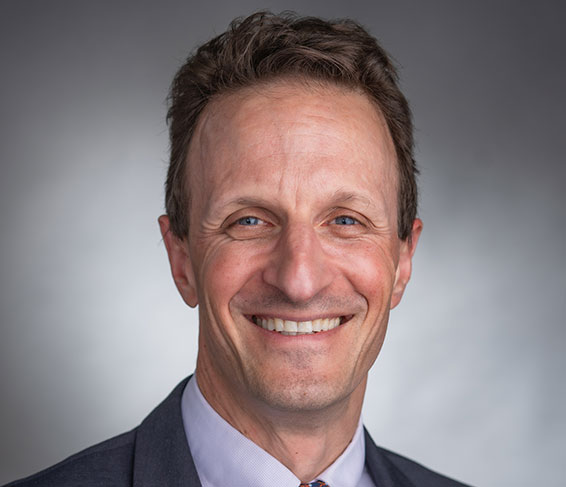Diffuse large B-cell lymphoma (DLBCL) is the most common form of non-Hodgkin lymphoma, diagnosed in more than 18,000 people in the U.S. every year. It is a fast-growing lymphoma that can arise in the lymph nodes or, more rarely, in organs such as the spleen, liver, and others.
As its name indicates, DLBCL involves the malignant growth of B lymphocytes, white blood cells that normally make antibodies to fight infection. It can occur at any age, but its incidence increases with age; half of patients are over age 60.
Even though it’s an aggressive lymphoma, DLBCL can be cured in most patients. The Adult Lymphoma Program at Dana-Farber Brigham Cancer Center offers patients access to a multidisciplinary team of lymphoma experts with extensive experience caring for patients with lymphoid malignancies. Our experts evaluate more than 1,500 new patients each year.
What is the first sign of DLBCL?
The most common symptoms are swollen lymph nodes in the neck, armpits, or groin. The swelling may occur rapidly and increase over time. Other symptoms may include:
- Unexplained fever
- Drenching night sweats
- Unexplained weight loss
- Pronounced fatigue
Because these symptoms are associated with a variety of conditions, it’s important to see your doctor to determine their cause.
How is DLBCL diagnosed?
Health care providers perform a variety of exams and blood and imaging tests to diagnose the disease. These may include:
- A detailed physical exam
- A lymph node biopsy, in which a small piece of the affected lymph node is removed and examined under a microscope
- A complete blood count, a test that analyzes the number and variety of cells within a blood sample
- A comprehensive metabolic panel, which measures the levels of more than a dozen different substances in the blood
- A positron emission tomography (PET) and/or computed tomography (CT) scan, to determine which parts of the body are affected by the lymphoma
The clinical team will also conduct genetic tests to determine which specific genetic mutations or abnormalities are present in the lymphoma cells.
What are the stages of DLBCL?
Physicians use the results of these tests to determine the extent of lymphoma within the body. Based on their findings, they assign one of four stages to the disease:
- Stage I – Lymphoma is found in one lymph node area or a single site outside the lymph nodes
- Stage II – Lymphoma is found in two or more lymph nodes, all either above or below the diaphragm
- Stage III – Lymphoma is in lymph nodes both above and below the diaphragm
- Stage IV – Lymphoma is in at least two areas, including one outside the lymph system, such as the liver or lung
Knowing the stage of the disease helps the clinical team select the appropriate treatment.
How is DLBCL treated?
The standard therapy is a combination of agents — the antibody drug Rituxan, the chemotherapy Cytoxan, Adriamycin, Oncovin, and Prednisone — known as R-CHOP.
A recent clinical trial known as the POLARIX study found that a combination of polatuzumab vedotin — an agent that consists of an antibody bound to a drug molecule — rituximab, cyclophosphamide, doxorubicin, and prednisone (Pola-R-CHP) demonstrated a 27% reduction in the relative risk of DLBCL progression, relapse, or death compared with RCHOP.
If the disease recurs, a range of treatments are available, including:
- An autologous stem cell transplant
- CAR T-cell therapy
- Other types of chemotherapy or immunotherapy
What is the latest research in DLBCL?
Researchers at Dana-Farber and elsewhere are working to develop and test new treatments. These include CAR T-cell therapies, which work by genetically equipping immune system T cells to better target and kill cancer cells. Current research focuses on developing safer, more effective forms of these therapies and understanding how resistance sometimes develops.
Dana-Farber investigators are leading several clinical trials of advanced CAR T-cell therapies for patients with DLBCL. In some cases, these include therapies targeting different proteins than existing CAR T-cell therapies do. An example is a trial of a therapy directed against the CD22 protein. Another trial involves a CAR T-cell therapy known as ONCT-808 in patients with relapsed, treatment-resistant, and aggressive B-cell malignancies. Another involves CAR T cells engineered to target two different cancer cell proteins at the same time.
Bispecific antibodies, which can bind to two different targets at a time, have shown great promise in DLBCL. Two, glofitamab-gxbm and epcoritamab-bysp, have been approved by the Food and Drug Administration for patients with relapsed or treatment-resistant DLBCL. Investigators at Dana-Farber are currently leading a clinical trial of the bispecific antibody glofitamab and the drug polatuzumab plus a standard chemotherapy regimen in patients with DLBCL.
Laboratory research is making significant advances as well. Scientists led by Dana-Farber’s Margaret Shipp, MD, have mapped the array of genetic alterations in hundreds of DLBCL tissue samples and identified five genomic subtypes of the disease. Investigators are now planning clinical trials to evaluate the effectiveness of specific treatments for these different subtypes.
Researchers are also exploring whether liquid biopsy tests, which look for cancer cell DNA in the blood, can be useful in determining whether patients are benefiting from treatment, and to what degree. Such tests could potentially be used to monitor patients’ response to treatment and, if the response is poor, to shift to an alternate therapy that may be more effective.
About the Medical Reviewer

Dr. Armand received his MD and PhD from the University of California, San Francisco in 2000. He completed his postgraduate training at Brigham and Women's Hospital and at Dana-Farber Cancer Institute in Boston. In 2007, he joined DFCI and is a member of the Hematologic Malignancies staff.
